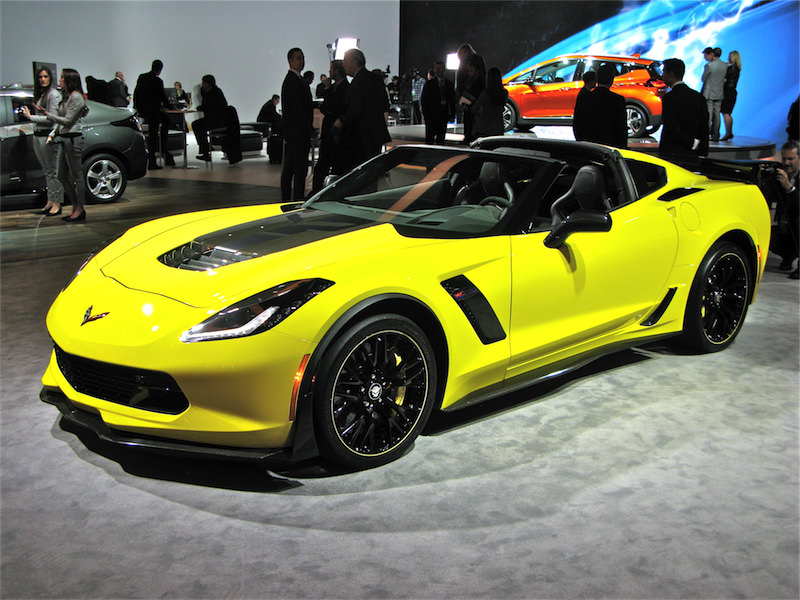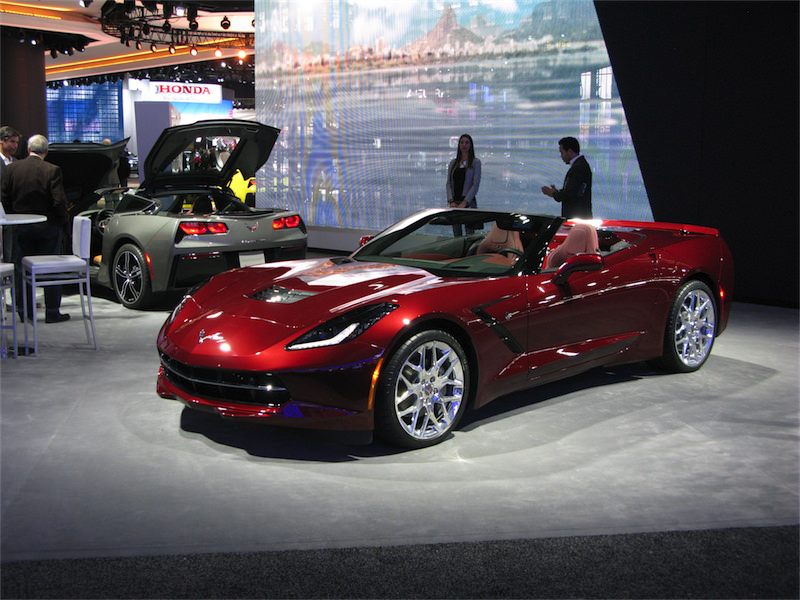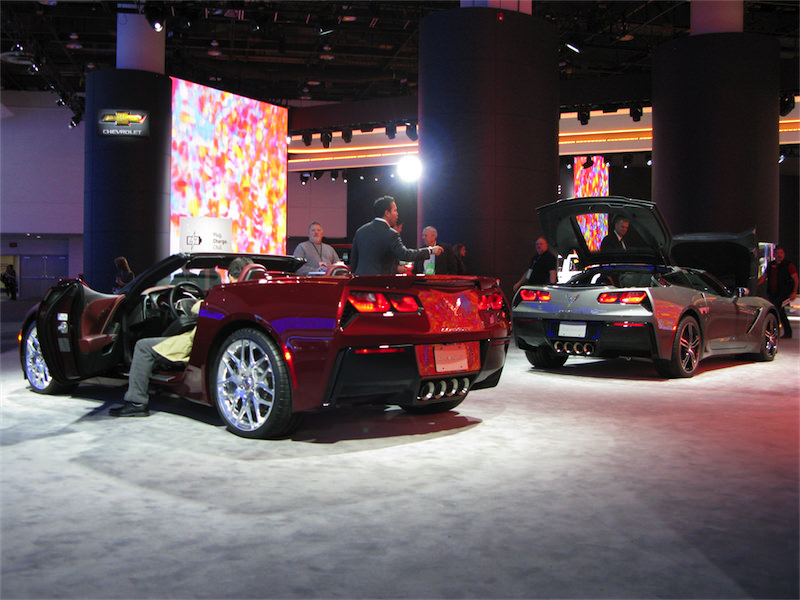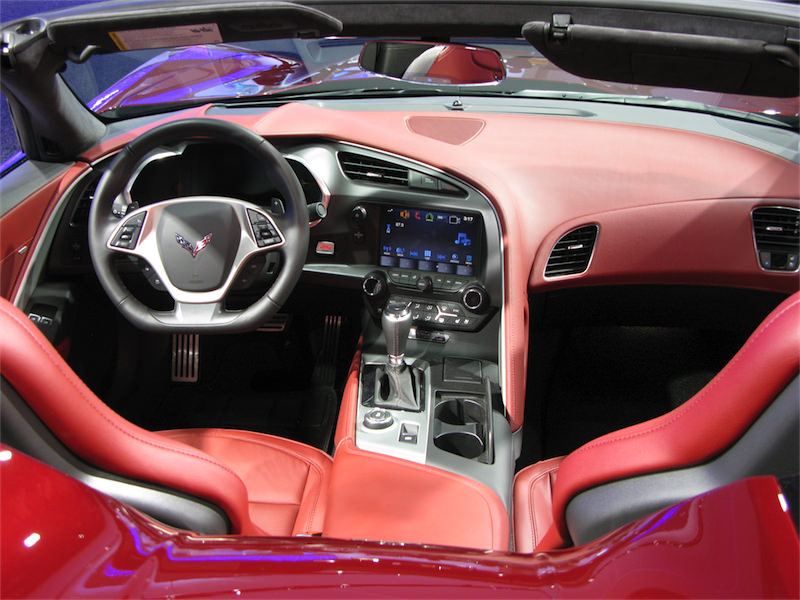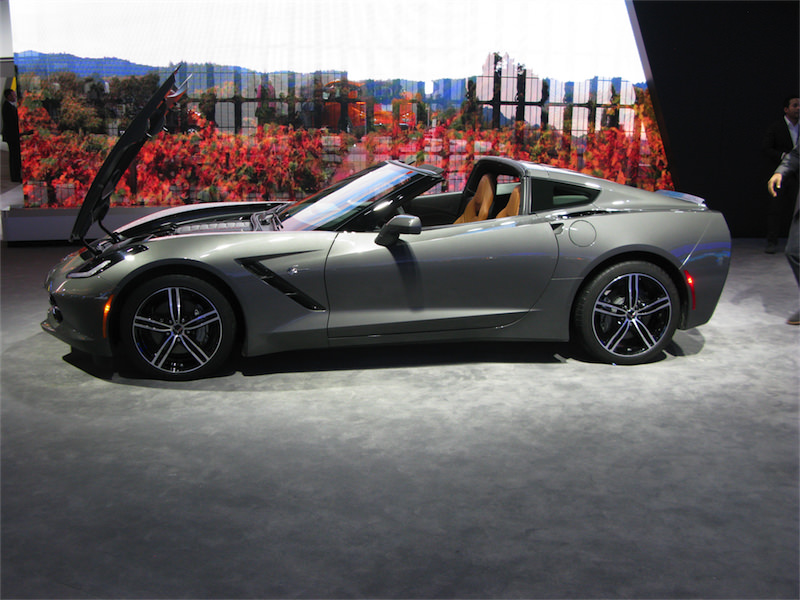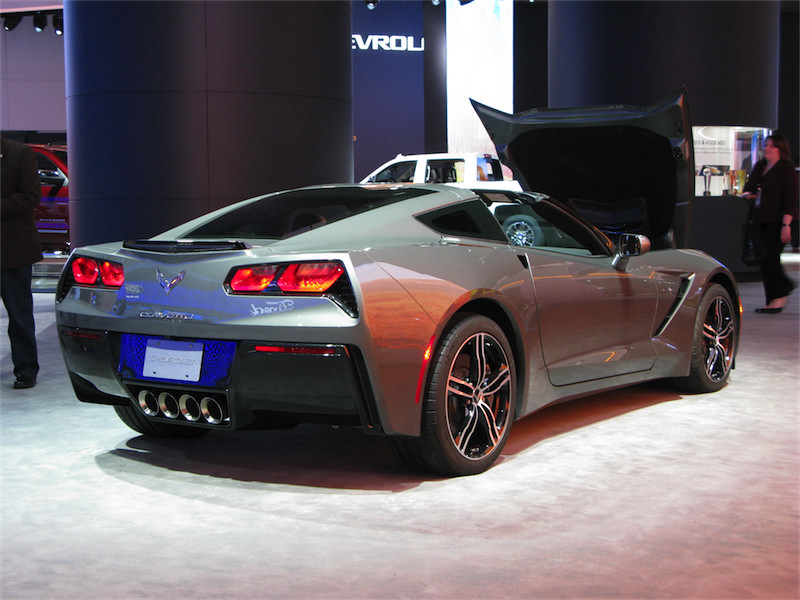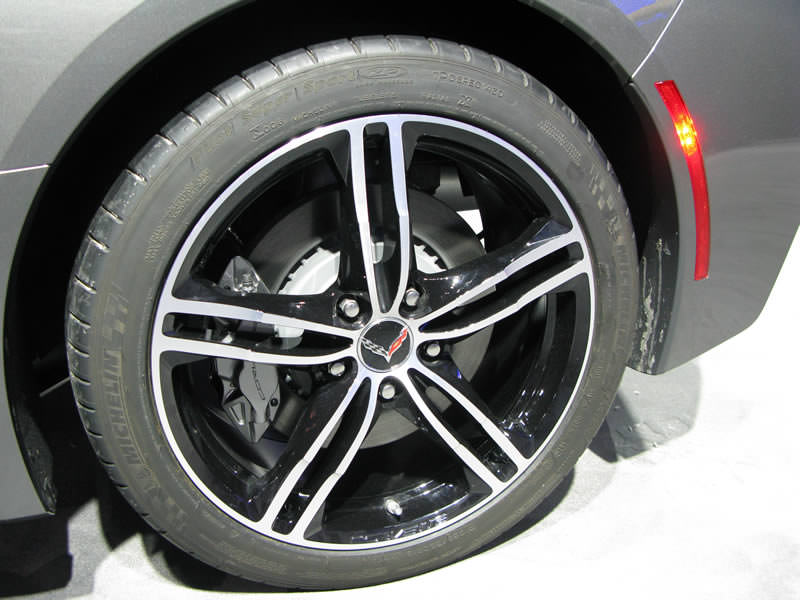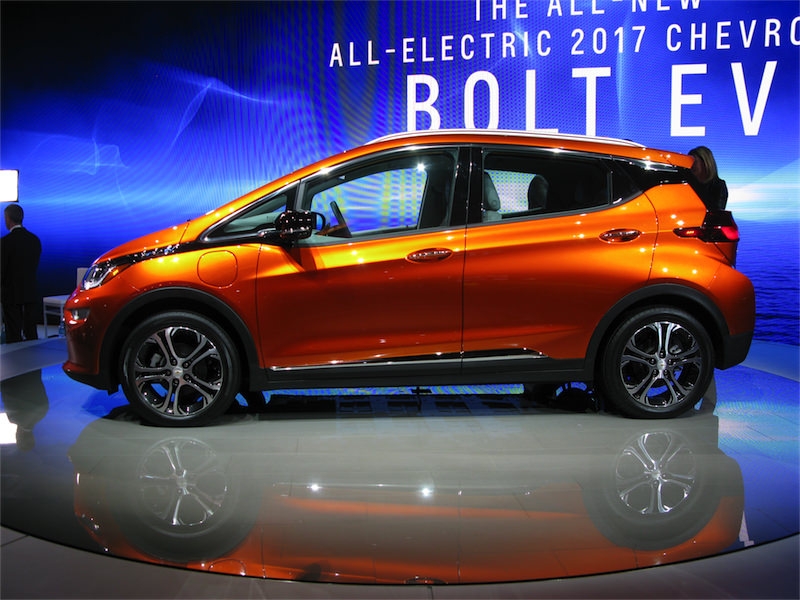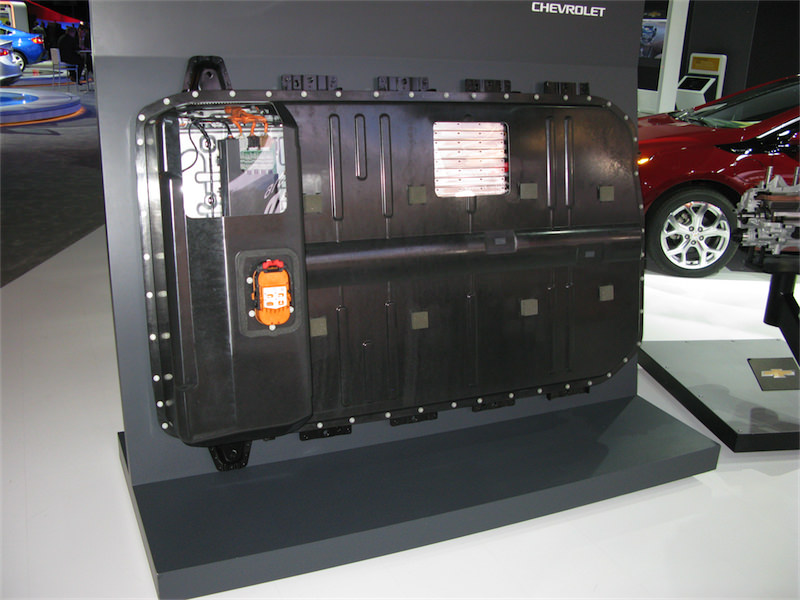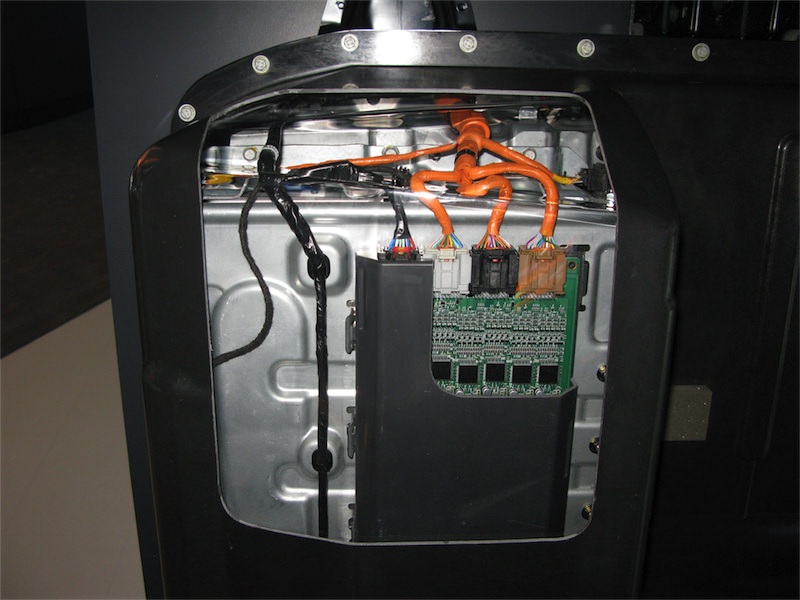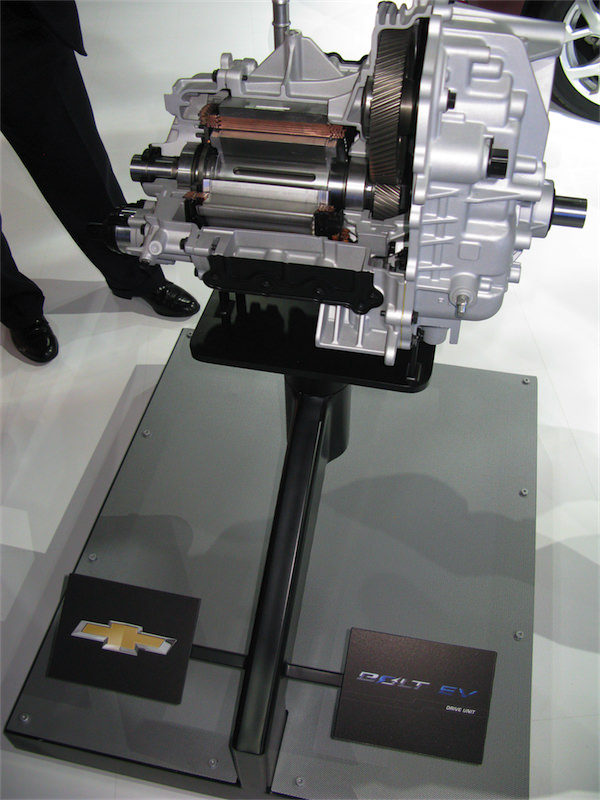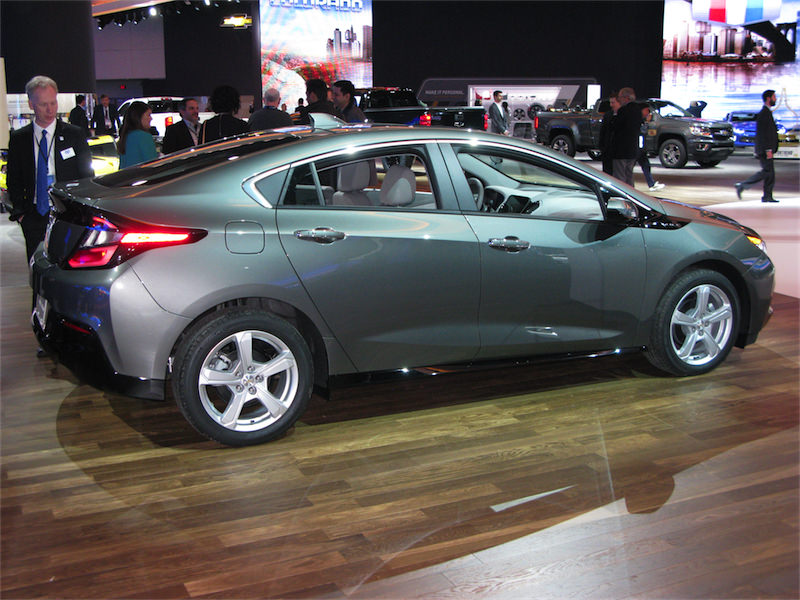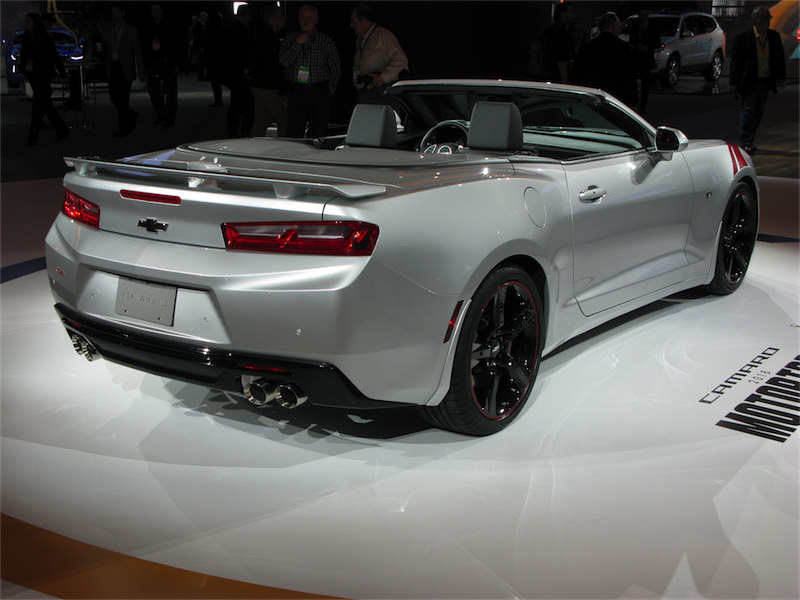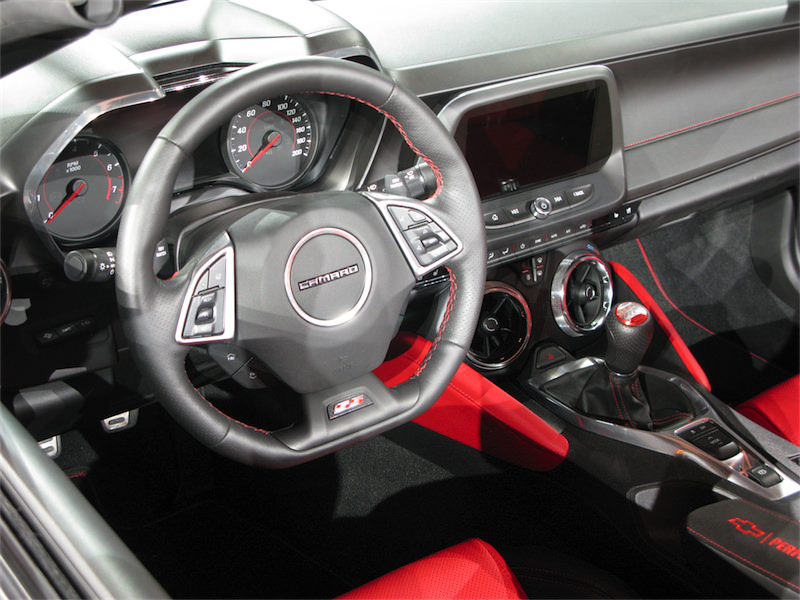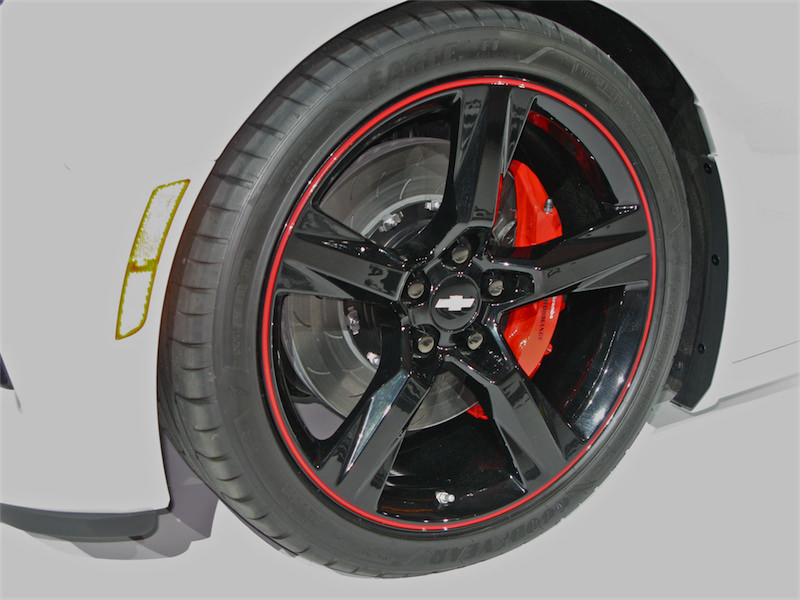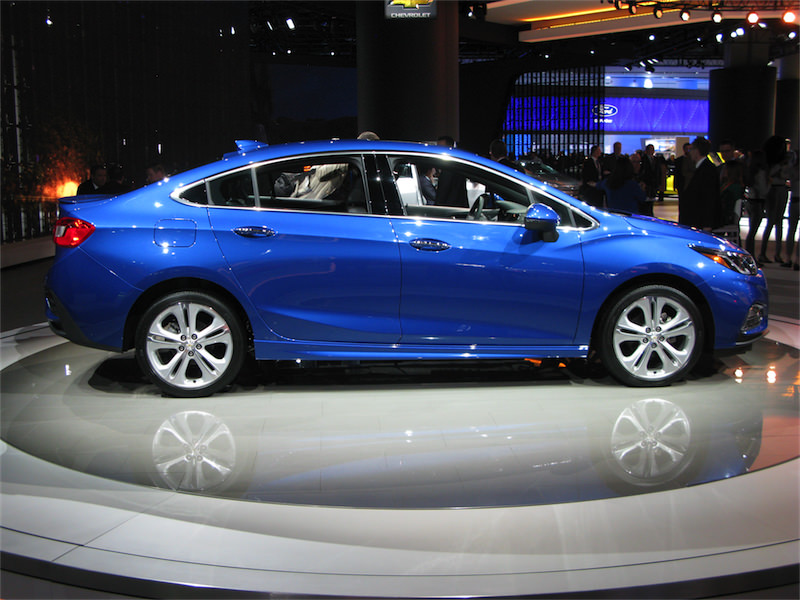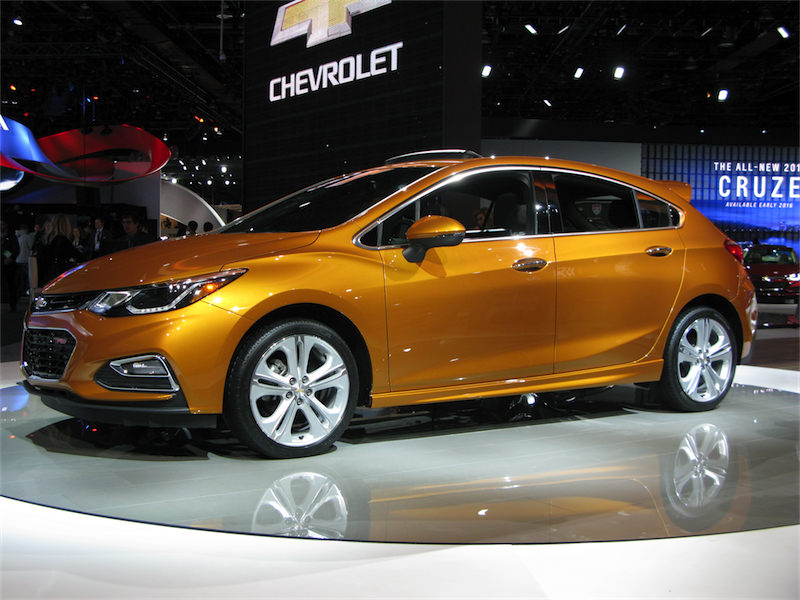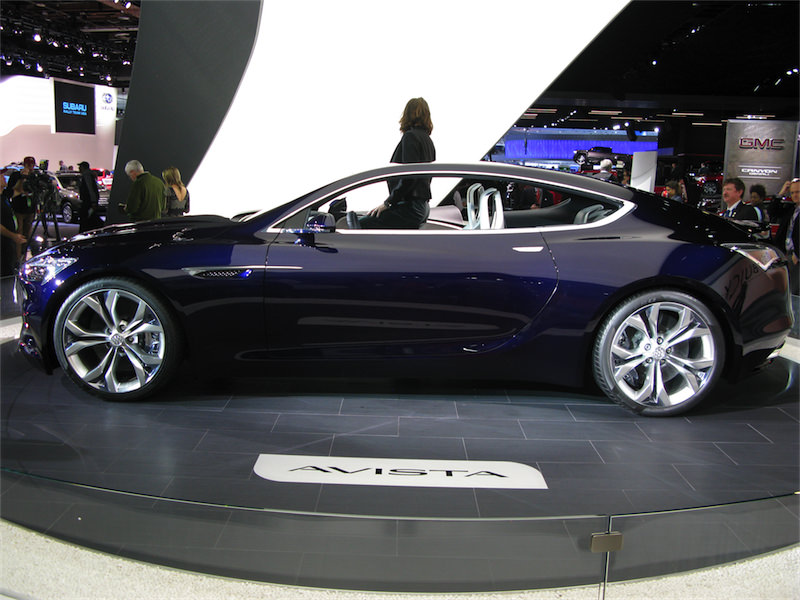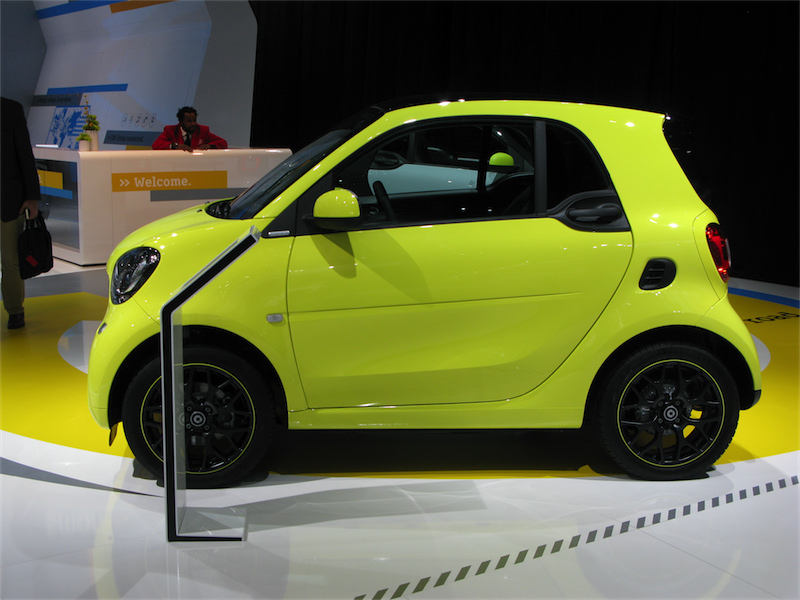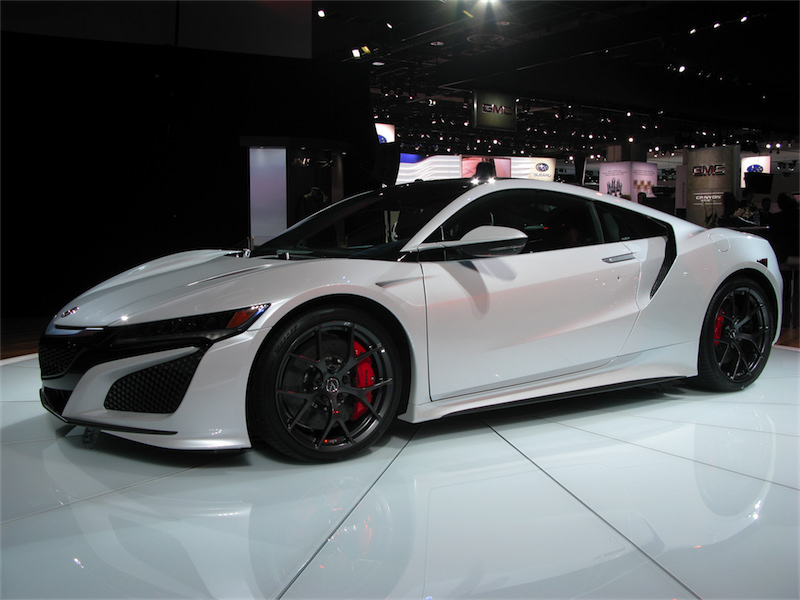In comments about last year’s 2015 North American International Auto Show held at Detroit’s Cobo Hall, I suggested that Corvette was on hiatus, having driven away with all the honors at the 2013 event with its introduction of the C7, then following up with more thunder at the 2014 show with Z06’s rebirth.
For this year, three Corvettes were off to the side of Chevrolet’s main display area. Z06 was represented by a Racing Yellow C7R Special Edition. I’m partial to yellow, so I find this package just stunning. There was a convertible in Long Beach Red with a Spice Red interior, and a Shark Gray coupe with Kalahari interior. I was dismayed to see the coupe’s tires and wheel wells were dirty, something I’d never seen on a NAIAS display car in the twenty-plus years I’ve attended. This was the first morning of the show’s media days, so I’m sure it got a proper detailing in due course. Maybe no one else noticed anyway. Yours truly was the only media type sitting on the floor shooting detail wheel photos. It all struck me as a sort of what-have-you-done-for-me-lately metaphor. New models can set the world on fire and be quickly overshadowed as the industry moves on. The C7, just entering the third year of its life cycle, it anything but irrelevant. But at NAIAS at least, it was no longer center stage.
Full disclosure: I admit to a strong positive bias toward GM, its products and its people. I started at General Motors Institute with a net worth of maybe $500 and graduated in 1970 with a engineering degree, zero student debt, and a nice Sting Ray. A small town guy who’d never been anywhere, I left GM for jobs that featured travel around the US and abroad. But I have always felt a special kinship to the company, especially the Corvette group.
Mentioning lack of media attention to the Corvettes on display emphasizes that the car business is one tough hombre, and that Apple might want to think twice before venturing into this big-boy playground. Apple has managed to become the world’s most valuable company, with a market cap currently twelve times that of General Motors, selling small electronic devices manufactured, for the most part, by subcontractors abroad. I’ve used Apple products since my first Mac in 1986. With an automotive background, it always astounded me that they could sell these expensive devices with warranties never longer than a year and built-in obsolescence that put other manufacturers to shame. Apple’s product design and customer service always outshined its competition, so when it hit the market with the iPhone in 2007, there was no holding it back. I bought Apple stock before the phone’s introduction and sold it for a modest profit before it really exploded, worried about Steve Jobs’ health and competitors that certainly would catch up. But Jobs left behind a solid management team and the competition, while fierce, hasn’t toppled Apple from its perch. But an Apple car?
The General did have some show stoppers, including the final production version of the pure electric 2017 Chevrolet Bolt. It is nicely styled and packaged right. Chevy categorizes it as a small station wagon because four-wheel drive won’t be available. But the package shouts crossover SUV, the industry’s hottest segment. If current trends continue, the Toyota RAV4 and Honda CRV will overtake Camry and Accord as the best selling passenger cars in the US. So the Bolt’s size and stance are spot on. It’s small, a bit tall and looks like nothing else without looking dopey. In fact, it’s downright handsome.
The Bolt’s range isn’t yet official, but 200 miles plus is assured. If you’ve read my coverage of earlier shows, you know I admire the Chevy Volt. From an engineering standpoint, it is incredible. But the concept of a limited range electric with a gasoline-engine generator to alleviate “range anxiety” is apparently too nuanced for average citizens to absorb. There’s a local talk show host I enjoy who has never been able to get past the Volt’s 40-mile electric range. Even his tech-whiz sidekick couldn’t grasp the range extender concept, commenting that one evening he was stuck in a stop-and-go traffic snarl behind a Volt and worried the Volt might be close to the end of its puny electric range. Truth be told, most Volt owners do manage to operate their Volts primarily on electricity, minimizing the use of gasoline. And Volt owner satisfaction is among the highest in the industry. But I’m coming around to the opinion that the Bolt is the game-changer, the end game, not the Volt. The Volt’s big drawback is that it has to carry the weight of that gas engine all the time. The Bolt directs that weight to a bigger battery. As one of the engineers who has been driving a Bolt prototype around Detroit for over a year told me, it’s hard to drive 200 miles in a day unless you’re on a road trip. Long trips won’t be practical with electrics until a national charging infrastructure and/or inductive road charging is in place. But for local driving? The Bolt does the job right now.
Rather than the “T” shaped battery in the Volt, the Bolt uses a rectangular battery unit that forms the bottom of the vehicle much like Tesla. Bolt’s battery unit is thicker than Tesla’s, with cells sourced from Korea’s LG. The cells are packaged in a composite shell bolted to a metal substructure which is bolted to the car, with the battery/substructure serving as a structural member. Tesla’s battery location and resulting low center of gravity is a big reason media gushes over its driving dynamics. The Bolt won’t out run any current Tesla, but with a similarly low center of gravity and 0-60 mph times in the seven-second range, Chevy promises a spirited driving experience. Expect a retail of around $30,000 after government incentives.
About those incentives. The federal government incentive for cars with sufficiently large batteries like the Volt, Leaf and all Teslas is $7,500. This is a tax credit. Consumers pay the full price for the vehicle, then receive a credit toward federal income taxes owed. If they do not owe more than $7,500 in the year of the car’s purchase, they’ll forfeit the remainder. It doesn’t carry over. Furthermore, this incentive starts to decline when a manufacturer’s total EV production reaches 200,000, then disappears completely when production reaches 250,000 (the feds never keeps things simple). A future administration could extend or modify the credit, and some states have additional incentives.
The Bolt will deliver the range and price Elon Musk has promised for Tesla’s next vehicle, the Model 3, promised for late 2017. But Tesla’s Model X SUV was three years late and production has ramped up slowly. According to the Wall Street Journal, Tesla has sued its supplier of the Model 3’s rear gull wing doors. Those doors were a head-scratcher and a risky bet in the first place. As of this writing, an actual prototype of the Model 3 has not been revealed. If Tesla meets its announced schedule, Chevy will still be there at least a year sooner. Speaking of being there, Tesla was nowhere to be found at the 2016 NAIAS. They’ve had a small, but prime spot at NAIAS for many years. They’ve typically had a vertically suspended battery pack display along with a car or two, and I’ve always enjoyed chatting with their reps. A Model X prototype was shown previously, but with it now rolling down the assembly line, it seemed odd they didn’t bring a production version this year...and more odd to skip the show completely. Michigan has taken a firm stance against Tesla’s direct-to-customer sales model, so perhaps Tesla didn’t care to participate in a Michigan-based event.
Chevrolet’s area included additional new models worthy of mention. Of course, the new Camaro, Motor Trend’s 2016 Car of the Year, was there. The new Chevy Cruze is a late-intro 2016, but NAIAS debuted the 2017 Cruze Hatchback. Nice looking, but available only as a four-door hatch. Why doesn’t Chevy offer a Cruze two-door coupe or hatch? True, other manufacturers have abandoned the segment, but Chevy always did well with the Cobalt coupe, and Honda continues with Civic two-doors. The Cruze has a good reputation, a six-speed manual is still available, and the engines are first rate. A sharp looking coupe seems like a no-brainer. I also don’t know why the Cobalt-based HHR wasn’t continued with a Cruze-based redo. My HHR SS is a hoot.
Chevrolet’s smallest and least expensive offering these days is its Korean-built Spark. It’s all new for 2017 and Chevy had one on display at NAIAS. I’d deem it less funky, more “grown up” in Chevy speak. It’s definitely better. The instrument display in the earlier car was awful, but much better in the new model.
The 2016 NAIAS had a fresh feel because most manufacturers shifted to new locations. For many years, all GM products were in one area. A few years back Cadillac split off with its own section. For this year, each GM division had a separate location.
In its space, Buick showed a new-for-the-US SUV, the Envision, sized between its tidy Sonic-based Encore and larger Envoy models. Conservative but nice enough, the Envision will be imported from China. Buick’s big reveal was the Avista, a highly-styled two-door coupe concept. AutoWeek picked it as Best in Show and media generally joined in, hoping the car gets green-lighted to production. The show car was said to be rear drive with a wheelbase shared with the new Camaro, so an Avista in your driveway is plausible.
Speaking of awards, AutoWeek picked the Chrysler Pacifica as Most Significant. Chrysler resurrected the Pacifica nameplate for this latest iteration of its minivan, a market segment Chrysler created three decades back. Big and handsome, and certainly a far cry from the K-car based original. Dan Gurney has been quoted as preferring a minivan for daily use because of its utility, comfy driving position and good sightlines. For me though, the current offerings have just gotten way too bloated.
Best Concept went to the Kia Telluride, a suicide-door (four), van-based crossover that AutoWeek guessed would wind up with Hyundai’s upscale Genesis division. For Most Fun, AutoWeek picked the 2017 Ford Raptor F150. Powered by a twin-turbo V6 (sourced from the GT) and coupled to a ten-speed automatic, it should out-scoot the V8 Raptor it replaces.
NAIAS starts each show with announcement of North American car and truck/suv of the year. This year the awards went to the Honda Civic and the Volvo XC90. Honda got roasted for its outgoing Civic’s cheapness and technical regression, attributable to complacency, me thinks. Honda got busy and gave the new model some needed attention. Maybe a bit much in the rear, but generally done well with a noticeable interior material uptick. Also new for Honda at NAIAS was its Ridgeline pickup truck. Again, Honda has gone its own way with a vehicle that is decidedly not mainstream. Trucks continue to sell like crazy in the face of cheap gas, so understandably Honda would like to rejoin the party. This new Ridgeline is more truck-like than the previous model, but still more car-like than competing pickups. Honda faithful will like it. Beyond that, I’m not sure.
As for the Volvo, its Chinese owners have had the good sense to keep their Swedish management, engineering and design teams largely in place. The XC90 is conservatively styled in the best Scandinavian tradition and should do very well.
Attending the Volkswagon press conference, I wondered if Michael Horn, VW’s CEO in the US, would mention the diesel scandal. I’ve read that Mr. Horn is well liked by VW’s dealers for his down-to-earth frankness. When the scandal first broke, he was quoted as saying, “We totally screwed up. We must fix these cars.” At NAIAS, Mr. Horn apologized at length for the scandal’s effect on dealers and customers and vowed to regain the trust of both. He could not be specific about what would be done with the 600,000 “clean” VW diesels already in the US as the company and federal regulators have yet to agree on a remedy. The criminality of the emission defeat devices VW employed would be enough to kill a normal company, but VW is no normal company. Porsche and Piech family members own roughly half and control voting, but the German state of Lower Saxony, where VW is based and has a huge presence, owns a significant chunk . With the government piece, and thousands of jobs at stake, VW will survive. But its operations in the United States are likely to be severely affected. It was the driving force for diesel passenger cars in the US and that market is now effectively dead. It will stay dead if VW doesn’t handle their US crisis properly, and may stay dead even if they do.
With a soft spot for small cars, I was anxious to see the new Smart For Two. Finally, a genuine 5-speed manual transmission is available along with a 6-speed dual-clutch automatic. Proportions are about the same, but styling took a hit. I thought the outgoing car was a terrific looking door stop, with striking two-tone paint schemes. Even with the new Smart’s better mechanicals, the styling has gone lumpy and the interior controls are...strange. Despite a curb weight around 2,000 lbs and a 1.0L 3-cylinder motor, mileage at 32/39/35 (premium fuel required) is barely better than aforementioned Cruze. Guess one could say the same for the Spark, but forced to choose in the tiny-tot sweepstakes, Spark gets my vote.
US auto sales in 2015 topped 17.5-million, the best year ever. Thanks to low fuel prices, sales of high profit trucks and big SUVs were disproportionately high. Industry leaders see more of the same for 2016, so one might have expected promotion of these vehicles at NAIAS. But no. The emphasis was on electrics, hybrids, self-driving technology, and coupe designs. In the past when fuel prices exploded or the economy tanked, auto industry execs got shellacked for poor planning. For now, they appear to have all bases covered.
Postscripts:
(1) On March 3, 2016, Michael Horn and VW parted ways by “mutual agreement.” To meet an April 20, 2016 deadline imposed by a San Francisco federal judge, VW proposed a combination of vehicle buybacks, lease cancellations, repairs and payments to US owners of some 600,000 VW diesel vehicles. The proposal was tentatively accepted, but details weren’t released and VW faces individual and class action lawsuits that will likely take years to fully resolve.
(2) On March 31, 2016, Tesla unveiled the prototype for its Model 3 with production slated for late 2017. Press and consumer reaction was strongly positive with Tesla claiming 400,000 preorders within a month. The Model 3 somewhat resembles a scaled-down Model S. It’s an elegantly styled 4-door sedan with a distinctively blunt front end treatment sans badges or grill. That front looks unfinished to me and I’d bet on some tweaking for the production version.
Click on a photo to view it larger:

